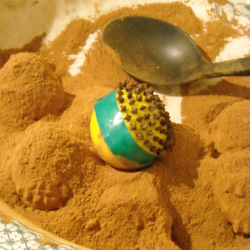How to make homemade pomanders
Posted by Fiona Nevile in Christmas, crafts | 8 comments
There are many beautiful moths that come into the cottage on summer evenings. They are welcomed and their beauty dazzles me and I hope that they will not drown in the washing up bowl. Then there are the clothes moths, the enemy that likes to guzzle our carpets and clothes. Any that I spot lolloping on the ceiling are killed by gently wiping my finger over them – yes our ceilings are that low. Despite the clothes moth murders hundreds of these greedy creatures manage to creep into our drawers and wardrobes each year with devastating results.
So when I discovered that moths hate cloves it was a moment of pure joy. Barbara Milo Ohrbach gave me this tip in her book The Scented Room. Suddenly the thought of making pomanders really appealed.
Apples, oranges, lemons, limes and even kumquats and grapefruit would all be suitable for making pomanders. Orange pomanders are the easiest to make due to their more even shape. I’m on the lookout for small juicing oranges on offer and meanwhile decided to start with small thin skinned lemons. Apparently thin skinned fruits are easier to work with but a knitting needle is essential to make the holes.
If you want to hang the pomanders, Ohrbach suggests leaving a half inch band (without cloves) around the fruit to make a slot for the ribbons. After a few hiccups I discovered that wrapping a band of plastic electrical tape made this task much easier. It makes a neat line to follow when adding the first row of cloves. The fruit will shrink during the curing process so the cloves need to have some space in between. I set my holes about a quarter of an inch apart as my cloves just had medium sized heads. Make a row of holes around the fruit following the line of the tape and then insert the cloves. I staggered my rows trying to make the pattern as even as I could.
Ohrbach’s pomanders are cured in a rich mix of spices, 6ozs of spice to half an oz of orris root powder (this fixes the scent). The mix is made up of cinnamon, allspice, nutmeg and ground cloves. As her recipe is still in copyright I can’t give you the mix here but cinnamon powder dominates and makes up just under half the mix. I doubled the recipe and found that I was short of nutmeg powder so added a little ground ginger instead which gave the mixture a bit more zing. The mixture can be used over and over again – hence the addition of orris root powder which fixes the scent – and stored in an airtight container when not in use. I can’t wait to have the confidence to create my own spice mix recipe to share with you here.
When the fruit has been studded with cloves remove the electrical tape and roll the fruit in the spice mix. Ideally cover the fruit completely with the spice mix. The fruit is then turned in the mix once or twice a day. When the fruit has dried totally the pomanders are ready. I have no idea how long that this takes but the kitchen smells heavenly so I’m happy if they take weeks to cure.
Note: I bought my cloves in bulk online – they are sold for crafts and unfit for culinary use. Each small lemon used an average of 8g of cloves. Out of 100g of cloves 10% were damaged but have been set aside to put into scented bags.
Leave a reply






Great post
You can buy cloves at asian supermarkets too about 400g for £4 i think, also cheap for all the other spices . Theres one called spices of india that does mail order if your not near to one .
Where do you buy the orris root ? although i do have some sandalwood oil somewhere ….and have some dried out lemons in the fruit bowl
Shaz
This was lovely and relaxing to do, I found a fork gave regular holes and was advised to use sandalwood oil as orris root can cause allergies for some. My fingers are now black with putting cloves in for two hours, but it was worth it.
Hi Shill
A fork! Why didn’t I think of that? Great idea.
I didn’t know that some people are allergic to orris root so thanks for that tip too.
I didn’t know that moths didn’t like the smell of cloves – that’s a useful thing to know.
I make the moth repellent potpourri style mix from the BBC Grow your own drugs programme ( http://www.bbc.co.uk/tv/features/growyourowndrugs/s2_episode1.shtml ) so I decided to pop a few cloves in too.
Hi Lally
Great suggestion, thanks. I’ve now started on ‘fun’ sized apples and the bowl is filling up fast 🙁
Hello Jo
I bought a kilo foe a song at http://www.daisyshop.co.uk in their sale. All gone now. I bought a lot of my other spices from here http://www.granarywholefoods.co.uk/search.aspx?keyword=cloves and checking today their organic cloves are cheaper than the ordinary ones. BTW the ones from Daisyshop are odd and unsorted – fine if you are filling bags or adding to potpourri but a bit of a headache when making a batch of pomanders.
Love the idea of us all smelling like Christmas puds!
P.S. You’ll have us all smelling like Christmas Puds at this rate – hee hee! What a yummy thought.
Hi Fiona – can you tell us where you got the cloves please? Cloves for me “cloves”(clothes) – what a great idea!
Fiona, this site suggests drying them in the dehydrator:http://bit.ly/9IWofP.
I might give that a go!